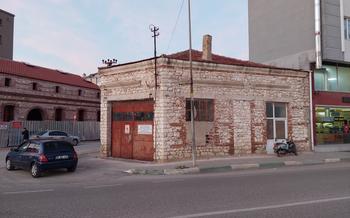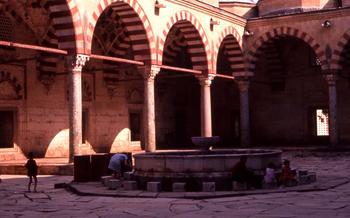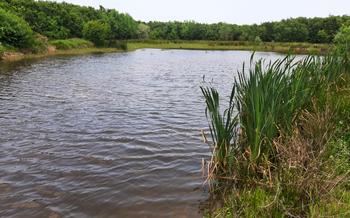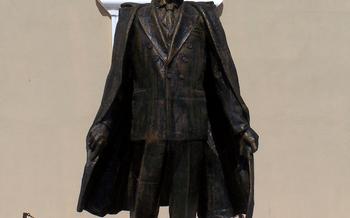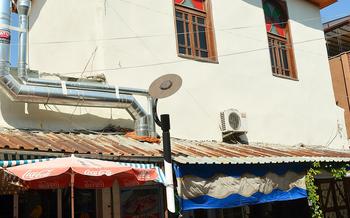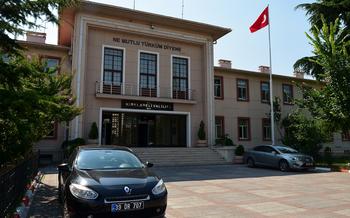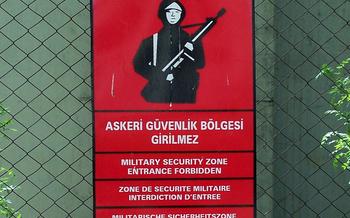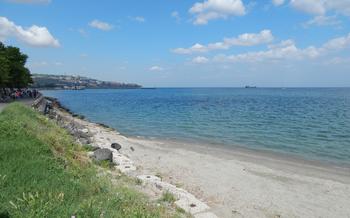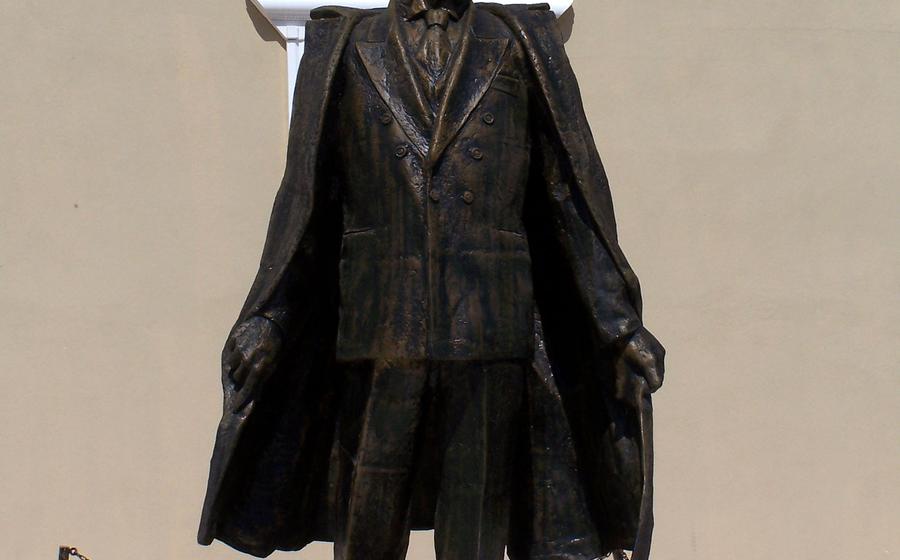
Lüleburgaz Balkan War Cemetery
- Lüleburgaz Balkan War Cemetery: A Historical Overview
- Location and Accessibility
- Layout and Design
- Honoring the Fallen
- Historical Context
- Symbolism and Legacy
- Graves and Tombstones
- Peace Park and Memorial Garden
- Visitor Etiquette
- Nearby Attractions
- Tips for Photography
- Educational Opportunities
- Local Customs and Traditions
- Sustainable Tourism
- Insider Tip: Hidden Gems
Lüleburgaz Balkan War Cemetery: A Historical Overview
Nestled in the heart of Lüleburgaz, Turkey, lies the Lüleburgaz Balkan War Cemetery, a poignant reminder of the human cost of war and a symbol of peace and reconciliation between Turkey and Bulgaria. Established in the aftermath of the Balkan Wars of 1912-1913, this sacred ground bears witness to the sacrifices made by thousands of soldiers from both sides of the conflict.
The Balkan Wars, a series of conflicts that engulfed the Balkan Peninsula, were marked by intense fighting and heavy casualties. The Lüleburgaz Balkan War Cemetery stands as a solemn tribute to the fallen soldiers, both Turkish and Bulgarian, who lost their lives during these tumultuous years. The cemetery serves as a poignant reminder of the shared history and intertwined destinies of these neighboring nations.
The burial of both Turkish and Bulgarian soldiers in the same cemetery symbolizes the spirit of reconciliation and peace that has gradually emerged between the two countries. The cemetery represents a commitment to understanding, forgiveness, and the rejection of violence as a means of resolving conflicts. It is a testament to the power of human compassion and the enduring hope for a peaceful coexistence among nations.
Location and Accessibility
The Lüleburgaz Balkan War Cemetery is strategically situated in the city of Lüleburgaz, within the Kırklareli province of Turkey. Its precise location can be found at 41°40'23"N 27°21'49"E. reaching the cemetery is relatively straightforward, with multiple transportation options available. Visitors can opt for a scenic train journey to Lüleburgaz station, followed by a short taxi ride or a leisurely walk to the site. Alternatively, the cemetery is easily accessible by car, with ample parking space available nearby.
For those seeking a comprehensive historical experience, the Lüleburgaz Balkan War Cemetery stands in close proximity to other significant landmarks. The city of Lüleburgaz itself boasts a rich cultural heritage, with attractions such as the Lüleburgaz Museum and the historic Grand Mosque. Additionally, the region is dotted with remnants of ancient civilizations, including Thracian tombs and Byzantine churches, inviting visitors to explore the diverse tapestry of history that Kırklareli holds.
Guided tours are readily available for those who prefer a more immersive and informative experience. Knowledgeable guides provide insights into the history of the Balkan Wars, the significance of the cemetery, and the stories of the soldiers who rest there. Whether you choose to wander through the cemetery independently or embark on a guided tour, the Lüleburgaz Balkan War Cemetery offers a unique and poignant journey into the past.
Layout and Design
The Lüleburgaz Balkan War Cemetery is a solemn and serene space, designed to honor the fallen soldiers and promote peace and reconciliation. The cemetery features a simple yet elegant architectural style, with rows of graves arranged in a grid-like pattern. The tombstones are made of white marble and bear the names, ranks, and dates of death of the soldiers buried beneath.
At the center of the cemetery stands a grand monument, a poignant reminder of the sacrifices made by soldiers from both sides of the conflict. The monument features intricate carvings and inscriptions commemorating the fallen and symbolizing the shared grief and longing for peace.
Landscaping and greenery play a vital role in creating a peaceful and contemplative atmosphere in the cemetery. Cypress trees, known for their longevity and resilience, line the pathways, providing shade and a sense of tranquility. Well-maintained gardens with colorful flowers and shrubs add vibrancy and beauty to the space, symbolizing the hope and renewal that emerged after the devastation of war.
Honoring the Fallen
The Lüleburgaz Balkan War Cemetery stands as a solemn tribute to the countless soldiers who paid the ultimate sacrifice during the Balkan Wars. Each grave tells a story of courage, sacrifice, and loss. Among those buried here are both Turkish and Bulgarian soldiers, their common fate uniting them in eternal peace.
The stories of individual soldiers buried in the cemetery are both heartbreaking and inspiring. One such story is that of a young Turkish soldier named Mehmetcik, who was just 18 years old when he was killed in battle. Mehmetcik's family was devastated by his death, but they found solace in knowing that he had given his life for his country.
Another poignant story is that of a Bulgarian soldier named Ivan, who was a father of two young children. Ivan was a kind and gentle man who loved his family dearly. When he was called to fight in the war, he knew that he might not return home, but he went anyway, out of a sense of duty and love for his country.
Commemorative ceremonies and events are held regularly at the cemetery to honor the fallen soldiers and to promote peace and reconciliation. These ceremonies are attended by representatives from both Turkey and Bulgaria, as well as by family members of the deceased. The ceremonies are a time to remember the sacrifices made by the soldiers and to celebrate the peace that now exists between the two countries.
Historical Context
The Balkan Wars, fought from 1912 to 1913, were a series of conflicts that reshaped the political and territorial landscape of the Balkan Peninsula. The wars involved several Balkan states, including Turkey, Bulgaria, Greece, Serbia, and Montenegro, as well as the major European powers of the time.
The Balkan Wars had their roots in the decline of the Ottoman Empire, which had ruled over much of the Balkans for centuries. As the Ottoman Empire weakened, nationalist movements arose in the Balkan states, seeking independence and self-determination.
The First Balkan War began in October 1912 when the Balkan League, an alliance of Serbia, Bulgaria, Greece, and Montenegro, declared war on the Ottoman Empire. The Ottoman forces were quickly defeated, and by the end of the war in May 1913, the Balkan League had succeeded in capturing most of the Ottoman territories in the Balkans.
The Second Balkan War broke out in June 1913 when Bulgaria, dissatisfied with the division of territories agreed upon in the Treaty of London, attacked its former allies Serbia and Greece. Romania also joined the war on the side of Serbia and Greece, and Bulgaria was eventually defeated.
The Balkan Wars had a profound impact on the region. The Ottoman Empire lost most of its European territories, and the Balkan states gained independence and expanded their territories. The wars also led to significant population movements, as many Muslims fled from the newly independent Balkan states to Turkey.
The Balkan Wars left a legacy of bitterness and resentment among the Balkan states, and the region remained a source of tension and conflict for many years to come.
Symbolism and Legacy
The Lüleburgaz Balkan War Cemetery stands as a powerful symbol of peace and reconciliation between Turkey and Bulgaria. The shared history and the sacrifices made by soldiers from both nations during the Balkan Wars are commemorated and honored here. The cemetery serves as a reminder of the futility of war and the importance of finding peaceful solutions to conflicts.
Over the years, the cemetery has become a symbol of reconciliation and friendship between the two countries. Joint commemorative ceremonies are held regularly, bringing together representatives from both Turkey and Bulgaria to pay their respects to the fallen soldiers and to reaffirm their commitment to peace and cooperation.
The cemetery's legacy extends beyond its role as a memorial. It serves as a reminder of the shared heritage and cultural exchange between Turkey and Bulgaria. The presence of Bulgarian soldiers buried alongside their Turkish counterparts highlights the deep historical ties between the two nations, dating back centuries.
The lessons learned from the Balkan Wars and the sacrifices made by those who fought in them continue to resonate today. The cemetery serves as an educational tool, reminding visitors of the devastating consequences of war and the importance of fostering peace and understanding among nations.
Graves and Tombstones
The Lüleburgaz Balkan War Cemetery is home to a diverse collection of grave markers and headstones that reflect the individual lives and stories of the soldiers buried here. Each grave is a unique tribute to the fallen, with inscriptions and engravings that provide a glimpse into their identities, backgrounds, and sacrifices.
The headstones vary in size, shape, and design, ranging from simple, rectangular slabs to more elaborate and ornate monuments. Some graves feature intricate carvings or inscriptions that depict religious symbols, military insignia, or personal motifs. Others are adorned with photographs or personal belongings left by family members, such as medals, helmets, or religious artifacts.
The variety of grave markers and headstones at the Lüleburgaz Balkan War Cemetery serves as a poignant reminder of the diverse backgrounds and experiences of the soldiers who fought and died in the Balkan Wars. These graves stand as a testament to the shared sacrifice and common humanity of those who lost their lives in this tragic conflict.
Peace Park and Memorial Garden
Adjacent to the Lüleburgaz Balkan War Cemetery lies a serene and contemplative space known as the Peace Park and Memorial Garden. This tranquil haven serves as a poignant reminder of the shared sacrifices and the enduring legacy of peace between Turkey and Bulgaria.
Designed with meticulous care, the Peace Park encapsulates the essence of reconciliation and remembrance. Visitors are welcomed by a lush expanse of greenery, where vibrant flowers and aromatic plants create a vibrant tapestry of colors and scents. Amidst this natural beauty, meandering paths invite visitors to explore the park's various features and pay homage to the fallen soldiers.
At the heart of the Peace Park stands a memorial garden, a sacred space dedicated to honoring the memory of those who lost their lives in the Balkan Wars. Here, visitors can pause and reflect upon the sacrifices made by soldiers from both sides of the conflict. The garden features meticulously arranged flower beds, each representing a different nationality or ethnicity of the fallen.
Benches strategically placed throughout the park offer visitors a place to sit, contemplate, and absorb the peaceful ambiance. These quiet moments of reflection allow visitors to connect with the history of the site and to appreciate the profound significance of peace and reconciliation.
Educational panels and signage are thoughtfully incorporated into the park's design, providing visitors with historical context and insights into the events of the Balkan Wars. These informative displays help visitors understand the complex political and military alliances, as well as the major battles and turning points that shaped the course of the conflict.
The Peace Park and Memorial Garden stand as a testament to the power of peace and the enduring bonds of friendship between Turkey and Bulgaria. It is a place where visitors can come together to remember the past, honor the fallen, and celebrate the triumph of peace over conflict.
Visitor Etiquette
When visiting the Lüleburgaz Balkan War Cemetery, it is important to observe proper etiquette to show respect for the fallen soldiers and the sacredness of the site. Here are some guidelines to follow:
- Respectful Behavior and Dress Code: Visitors should dress modestly and behave respectfully, avoiding loud conversations or disruptive actions.
- Silence and Contemplation: The cemetery is a place for quiet reflection and remembrance. Visitors are encouraged to maintain silence and avoid disturbing the peaceful atmosphere.
- Photography Guidelines: Photography is permitted in the cemetery, but visitors should be mindful of their surroundings and avoid taking photos that may be disrespectful or intrusive. Using flash or tripods should be done discreetly to minimize disturbance.
- Donations and Support: Visitors who wish to support the upkeep and preservation of the cemetery can make donations or contribute to restoration efforts. Donations can be made through designated channels or by contacting the local authorities responsible for the site's maintenance.
Nearby Attractions
Beyond the somber reflection of the Lüleburgaz Balkan War Cemetery, the town of Lüleburgaz itself offers a tapestry of historical and cultural experiences. Immerse yourself in the town's rich past at the Lüleburgaz Museum, home to artifacts and exhibits showcasing the region's journey through time.
Stroll through the vibrant streets and soak in the local atmosphere. Discover hidden gems like the historic Ottoman clock tower, a symbol of the town's architectural heritage. Indulge in the flavors of Turkish cuisine at local restaurants, tantalizing your taste buds with traditional dishes and delicacies.
Extend your exploration by venturing into the surrounding towns and villages. Explore the ancient ruins of Bizye, once a thriving Byzantine city, or delve into the natural wonders of Yıldız Mountains National Park, a haven for outdoor enthusiasts.
Accommodation options in Lüleburgaz range from cozy guesthouses to modern hotels, catering to travelers' diverse preferences. Whether you seek a tranquil retreat or an immersive cultural experience, Lüleburgaz offers a wealth of possibilities.
Tips for Photography
Capture the Emotions and Atmosphere
When photographing the Lüleburgaz Balkan War Cemetery, it's essential to go beyond capturing the physical structures and graves. Aim to convey the emotions and atmosphere that surround this sacred place. Look for moments of reflection, remembrance, and peace among visitors. Photograph the expressions on people's faces as they pay their respects. Capture the soft light filtering through the trees, casting a serene glow on the graves.
Respectful Use of Flash and Tripods
Be mindful of the respectful nature of the cemetery when using photography equipment. Avoid using flash photography, as it can be disruptive and disrespectful to visitors who are quietly contemplating or praying. If you need to use a tripod for stability, set it up carefully to ensure that it doesn't obstruct walkways or disturb others.
Composition and Storytelling Techniques
Use composition and storytelling techniques to create compelling and meaningful photographs. Experiment with different angles and perspectives to convey the scale and grandeur of the cemetery. Incorporate elements like tombstones, trees, and the surrounding landscape to create depth and visual interest. Consider using selective focus to draw attention to specific elements, such as a soldier's name engraved on a headstone.
Educational Opportunities
The Lüleburgaz Balkan War Cemetery offers a wealth of educational opportunities for visitors of all ages. Guided tours are available, providing in-depth historical insights into the Balkan Wars, the lives of the soldiers buried here, and the significance of the cemetery as a symbol of peace and reconciliation. These tours are led by knowledgeable guides who bring the history of the site to life, making it a truly immersive experience.
Educational programs are also available for schools and groups, tailored to specific age levels and interests. These programs may include interactive exhibits, multimedia presentations, and hands-on activities that help students learn about the Balkan Wars and the importance of peace and reconciliation.
In addition, there are online resources and virtual tours available for those who are unable to visit the cemetery in person. These resources provide detailed information about the site, its history, and the soldiers buried there, allowing visitors to explore the cemetery from anywhere in the world.
Local Customs and Traditions
When visiting the Lüleburgaz Balkan War Cemetery, it is important to be respectful of local customs and traditions. Turkey and Bulgaria have a rich cultural heritage, and understanding their customs will enhance your experience and foster meaningful interactions with the locals.
In both countries, it is considered polite to greet people with a handshake or a nod. When meeting someone for the first time, it is customary to exchange pleasantries and inquire about their well-being. When entering a home or a place of worship, it is important to remove your shoes.
In Turkey, it is considered rude to point your finger at someone or to speak loudly in public. It is also important to dress modestly, especially when visiting religious sites. In Bulgaria, it is customary to say "cheers" ("Nazdrave") before drinking alcohol. It is also considered polite to leave a small tip for services rendered.
When interacting with locals, it is important to be patient and understanding. Many people in the region may not speak English fluently, so be prepared to communicate using gestures or with the help of a translation app.
By respecting local customs and traditions, you can show your appreciation for the culture and heritage of Turkey and Bulgaria, and create a positive and memorable experience for yourself and the people you meet.
Sustainable Tourism
As you explore the Lüleburgaz Balkan War Cemetery, consider adopting sustainable tourism practices to minimize your environmental impact and support the local community. Here's how:
Transportation: Opt for public transportation, walking, or biking to reach the cemetery, reducing carbon emissions and promoting a healthier lifestyle.
Local Economy: Support local businesses by purchasing souvenirs, handicrafts, or refreshments from nearby shops and vendors. This helps sustain the local economy and preserves traditional livelihoods.
Responsible Packaging: Avoid single-use plastics and opt for reusable containers or biodegradable packaging whenever possible.
Waste Management: Dispose of waste properly in designated bins and avoid littering to maintain the cleanliness and beauty of the site.
Cultural Sensitivity: Respect local customs and traditions, dress appropriately, and be mindful of your behavior to foster positive interactions with the community.
Community Engagement: Engage with locals, learn about their culture, and share your experiences to promote cross-cultural understanding and appreciation.
Preservation: Handle artifacts and monuments with care, and avoid touching or climbing on structures to preserve their integrity for future generations.
By embracing sustainable tourism practices, you can contribute to the long-term preservation of the Lüleburgaz Balkan War Cemetery while supporting the well-being of the local community.
Insider Tip: Hidden Gems
Beyond the main cemetery grounds, explore the hidden gems that offer a deeper connection to the history and significance of the site. Discover the unmarked graves of soldiers who fell in battle, scattered among the fields surrounding the cemetery. These forgotten resting places serve as a poignant reminder of the countless lives lost during the Balkan Wars.
Delve into the nearby village of Yenice, where you can immerse yourself in the local culture and traditions. Engage with the friendly villagers, learn about their way of life, and savor the flavors of traditional Turkish cuisine. The village is home to skilled artisans who create beautiful handmade crafts, providing a unique opportunity to support local talent and take home a piece of the region's heritage.
For a serene escape, venture to the nearby Erikli Lake, a natural paradise teeming with diverse wildlife. Stroll along the tranquil shores, admire the stunning sunsets, and soak in the tranquility of this hidden oasis. Embrace the opportunity to connect with nature and find solace amidst the beauty of the surroundings.
